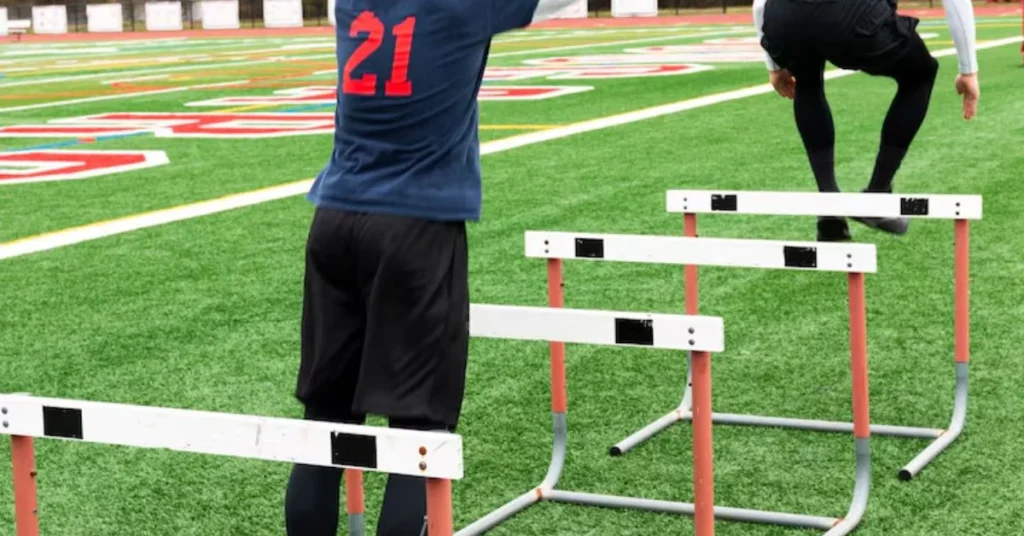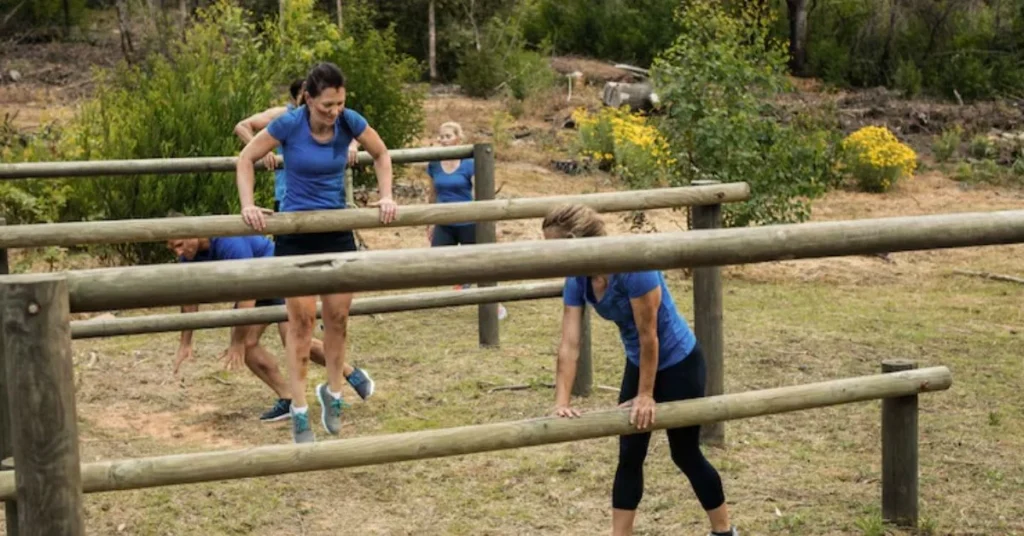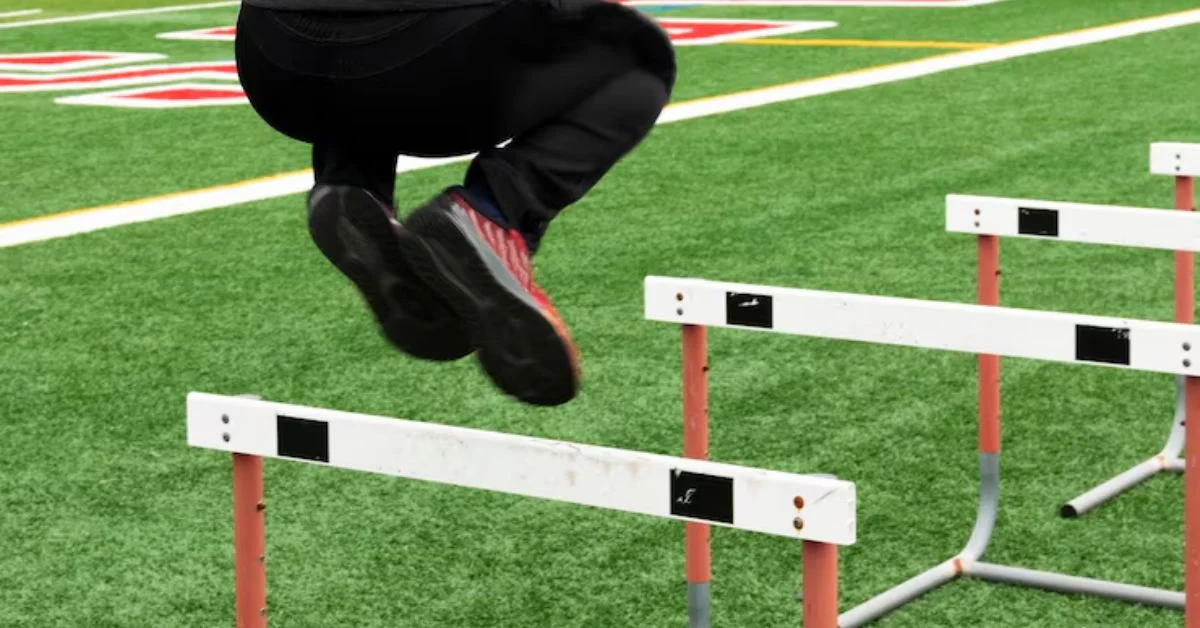HURDLE TECHNIQUE- The difficult and one-of-a-kind track and field event known as hurdles calls on agility, rhythm, speed, and pinpoint coordination. Improving an athlete’s performance, safety, and self-assurance may be achieved via the proper instruction of hurdle skills.
For track and field coaches, physical education instructors, and athletic trainers looking to help novice hurdlers or elite hurdlers hone their trade, this is the perfect resource.
Understanding the Fundamentals of Hurdling
Jumping and running rhythmically over barriers that are spread out at regular intervals is what hurdle racing is all about. Not only must you overcome the obstacle, but you must accomplish so without halting your progress.
Events Include:
- 100m hurdles (women)
- 110m hurdles (men)
- 400m hurdles (both genders)
Each event demands specific rhythm patterns and technical refinement, but the foundational mechanics remain largely the same.
The Importance of Teaching Proper Hurdle Technique
Proper hurdle technique enhances performance, prevents injuries, and builds athlete confidence. Teaching poor mechanics can lead to:
- Hamstring strains
- Hip impingements
- Slower times due to improper lead/trail leg form
Benefits of Proper Technique:
- Efficient energy use
- Increased speed between hurdles
- Reduced contact time with the ground
Key Components of Hurdling
To teach hurdles effectively, understand the core elements of hurdling:
1. Lead Leg Mechanics
- The leg that first clears the hurdle
- Should be straight but not locked
- Toes flexed upward to clear the hurdle
2. Trail Leg Mechanics
- Follows immediately after the lead leg
- Should be high and fast through the hip
3. Arm Action
- Opposite arm drives forward with the lead leg
- Arms should stay relaxed, not flail
4. Hurdle Clearance
- Minimal vertical jump; focus on horizontal momentum
- Hips should stay at consistent height
5. Stride Pattern
- 3-step rhythm between hurdles in sprint events
- 13–17 strides for 400m hurdles depending on athlete level
Equipment and Safety Considerations
Before teaching hurdle techniques, make sure your training area is:
- Flat and clear of debris
- Equipped with adjustable training hurdles
- Outfitted with landing mats for beginners
- Properly spaced for each age/skill level
Recommended Equipment:
- PVC hurdles for beginners
- Cone markers for foot placement
- Resistance bands for mobility work
Warm-Up and Mobility Drills
A well-designed warm-up enhances performance and reduces injury risk.
General Warm-Up (5–10 minutes):
- Jogging
- High knees
- Butt kicks
Dynamic Mobility (5–10 minutes):
- Leg swings
- Hip circles
- Hurdle walk-overs (front and side)
Activation Drills:
- A-skips
- Bounding
- Ankle pops

Step-by-Step Guide on How to Teach Hurdle Techniques
Step 1: Start with Walking Over Hurdles
- Emphasize proper posture
- Practice lead and trail leg form slowly
Step 2: Introduce Lead Leg Isolation Drills
- Use a low hurdle or cone
- Focus on knee drive and full extension
Step 3: Introduce Trail Leg Isolation Drills
- Use wall or rail for support
- Emphasize speed through the hip and snap over
Step 4: Combine Lead + Trail Movement
- Perform over a series of 2–3 low hurdles
- Keep rhythm consistent
Step 5: Add Sprint Mechanics Before and After Hurdles
- Sprint into hurdle, recover with a few sprint steps
Step 6: Introduce Full Hurdle Rhythm Drills
- Use proper spacing for athlete’s age/height
- Focus on flow rather than speed at first
Drills to Improve Hurdling Form
Lead Leg Drill Over Cone
- Builds confidence and proper leg extension
Wall Trail Leg Drill
- Isolates trail leg mechanics
Hurdle Mobility Drills
- Increases range of motion and coordination
Bounding Drills
- Improves rhythm between hurdles
Sprint + Hurdle Combo
- Combines speed with form under fatigue
Common Mistakes and How to Correct Them
1. Popping Up Over the Hurdle
- Fix: Encourage horizontal motion, not vertical
2. Improper Trail Leg Mechanics
- Fix: Use drills to focus on fast trail recovery
3. Poor Arm Coordination
- Fix: Mirror drills to match arm to leg movement
4. Breaking Stride Before Hurdle
- Fix: Practice approach runs to build confidence
5. Overreaching Between Hurdles
- Fix: Focus on stride frequency, not length
Adapting Techniques for Different Age Groups
Youth Athletes (8–12):
- Use mini hurdles
- Emphasize fun and basics
Middle School Athletes:
- Start with 2–3 hurdles in a row
- Introduce trail leg drills
High School & Collegiate:
- Focus on competitive rhythm and race strategy
- Emphasize conditioning and phase-specific workouts
Masters Athletes:
- Modify hurdle height and spacing
- Prioritize joint mobility and strength
Progress Tracking and Performance Metrics
Tracking progress helps athletes stay motivated and allows coaches to adjust training accordingly.
Key Metrics:
- Hurdle clearance time
- Stride count and cadence
- Race splits
- Hurdle-to-hurdle time
Tools:
- Stopwatch
- Video analysis apps
- Wearables (e.g., GPS timing units, foot pods)
Expert Tips from Elite Coaches
- “Mastering the trail leg is often what separates good hurdlers from great ones.” – Coach Jim Radcliffe
- “Less is more. Focus on one technical cue per session.” – Coach April Thomas
- “Video feedback is one of the fastest ways to correct posture and hurdle clearance.” – Coach Ben Davis
Suggested Coaching Progression:
- Movement patterns
- Rhythm
- Speed
- Competition readiness

Conclusion:HURDLE TECHNIQUE
Athletes need more than only the ability to leap a barrier to benefit from knowing how to instruct them in hurdle tactics. The key to going from zero to hero as a hurdler is developing self-assurance, rhythm, and effective biomechanics.
Coaches may help athletes of any skill level learn to hurdle with authority and accuracy by using specific drills, a gradual training program, and regular feedback.
FAQs: HURDLE TECHNIQUE
1. What is the best age to start hurdling?
Children can begin light hurdling drills as early as 8–10 years old using mini hurdles with a focus on fun and form.
2. How can I teach the trail leg more effectively?
Isolate the movement using a wall drill or resistance band to focus on speed and hip activation.
3. What’s the ideal stride count between hurdles?
Most elite hurdlers use a 3-step pattern in sprint hurdles; 400m hurdlers vary between 13–17 strides depending on ability.
4. How do I keep athletes from jumping too high?
Use flat cones or low hurdles and stress maintaining level hips through the hurdle.
5. Can I teach hurdling without access to a full track?
Yes, use cones, lines on a field, or portable hurdles to simulate proper spacing and technique.
For more information, click here.









